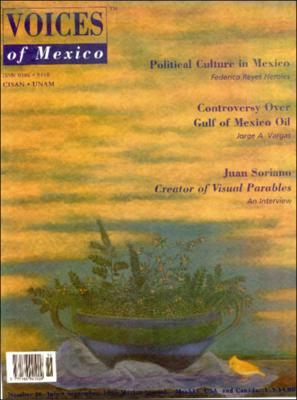Mostrar el registro sencillo del ítem
Voices of Mexico
| dc.rights.license | http://ru.micisan.unam.mx/page/terminos | |
| dc.contributor.editor | Bugeda Bernal, Diego Ignacio | |
| dc.contributor.other | Velasco Montante, Astrid | |
| dc.date.accessioned | 2018-12-04T00:41:54Z | |
| dc.date.accessioned | 2022-02-17T00:16:05Z | |
| dc.date.available | 2018-12-04T00:41:54Z | |
| dc.date.available | 2022-02-17T00:16:05Z | |
| dc.date.issued | 1996 | |
| dc.identifier.issn | 0186-9418 | |
| dc.identifier.uri | https://ru.micisan.unam.mx/handle/123456789/16743 | |
| dc.format | application/pdf | |
| dc.format.extent | 120 pp. | |
| dc.language.iso | eng | |
| dc.publisher | Universidad Nacional Autónoma de México, Coordinación de Humanidades, Centro de Investigaciones sobre América del Norte | |
| dc.relation.isformatof | ||
| dc.relation.haspart | Our Voice / Márquez Padilla, Paz Consuelo; Political Culture in Mexico: Paradoxes at the End of the Century / Reyes Heroles, Federico; The Political Reform of the Mexican State / Gutiérrez López, Roberto J.; XIII Meeting of the Mexico-Unisted States Binational Commission; The 1996 U.S. Presidential Elections Implications for Mexico / Driscoll de Alvarado, Bárbara; Racism and Early U.S. Foreign Policy / Valdés Ugalde, José Luis; The Discovery of Great Manhattitlan / Valdés, Luz María; Juan Soriano: creator of Visual Parables; The Morphology and Functions of the Brain / Gutiérrez Ospina, Guillermo; The Pre-Columbian/ Montiel Ziegler, Elsie; Lola la Grande: Singer of the Mexican Spirit / Montiel Ziegler, Elsie; An Interview with Barbabara McDougall / Castro Rea, Julián; Mexico"s Floristic Diversity / Dirzo, Rodolfo; Medicinal Plants in Mexico / Bye, Robert; Linares, Edelmira; The Mexican Room in the British Museum; Prozac Nation. Young and Depressed in America. A Memoir / Martínez-Zalce, Graciela; Los mexicanos de los noventa ( Mexicans of the Nineties) / Constantino Toto, Mario C.; On the Tracks of Migration and Cooperation Latapí Ortega, Dolores Dog / Valadez Azúa, Raúl; On Nahuatl Wisdom; News from Aztlan / Bugeda Bernal, Diego Ignacio; Mexican Candies: A Bit of Edible History / Wehnes, Lynn; Land Use and the Restoriation of the Exconvent of Santo Domingo de Guzmán, Oaxaca / Fernández Dávila, Enrique; Albrecht Durer in the National Library / Torres Escalona, Luis Roberto; Economic Change and Labor Market Integration in North America / Levine Leiter, Elaine; Oil and Natural Gas: A Legal Dispute Brewing in the Gulf of Mexico (Part One) / Vargas, Jorge A.; Jaime García Terres: Untiring Cultural Promoter and Outstanding Poet (1924-1996) / Bugeda Bernal, Diego Ignacio; Julian Samora: A Silent Warrior | |
| dc.relation.requires | Adobe Acrobat | |
| dc.subject | HUMANIDADES Y CIENCIAS DE LA CONDUCTA | |
| dc.title | Voices of Mexico | |
| dc.audience | Estudiantes | |
| dc.audience | Maestros | |
| dc.audience | Investigadores | |
| dc.audience | Otros públicos | |
| dc.audience | Medios de comunicación | |
| dc.contributor.assistanteditor | Montiel Ziegler, Elsie | |
| dc.contributor.assistanttotheeditorinchief | Creamer, Cynthia | |
| dc.contributor.assistanttotheeditorinchief | Gutiérrez, Fernando | |
| dc.contributor.businessmanager | Ocampo, Consuelo | |
| dc.contributor.copyeditorandtranslator | Dashner Monk, Heather | |
| dc.contributor.designer | García Ascot, Soren | |
| dc.contributor.editorinchief | Márquez Padilla, Paz Consuelo | |
| dc.contributor.layout | Ediciones del Equilibrista | |
| dc.contributor.printer | Offset Rebosán | |
| dc.contributor.salesandcirculationmanager | Villareal Carrillo, Pilar | |
| dc.coverage.placeofpublication | México | |
| dc.date.printcopyrighted | [ca. 1996] | |
| dc.description.extract | We are on the verge of the twenty-first century and the bipolar world has disappeared. The United States has assumed a leading role in structuring a new world order. Yet it seems it needs its own restructuring first. They can still change the agenda, but unfortunately in their 1996 election, they seem to be guided more by petty interests and nationalist excesses than by the longterm goal of a better world order. Economic globalization and the resulting restructuring as brought uncertainty This is fertile soil for distrust and resentment. It is not just a master of unemployment but of constantly changing jobs and lower wages. Two types of discourse can emerge from it: one of hate, closed markets and absurd nostalgia for something that perhaps never existed or a discourse of hope, open markets and a sense of positive transition that challenges all previous understanding. It is true that progress, development and the market have not brought all the dreams that we had opened for, but, to our benefit, some negative effects have been tempered and a sense of new possibilities has been reintroduced such as the ones provided by the rational part of the environmental movement. Mexico is undergoing its own changes, politically as well as economically. Jorge Dominguez and James A. McCann, based on different electoral surveys, show that Mexicans are ready for political change and aspire to greater democracy. They also point out that —contrary to what most people might believe— authoritarianism is not distinctive of a single arty, but that there have been democrats and authoritarians across the spectrum of Mexico"s system of political parties. They mention party membership or partisan identification as the most important variable to explain the vote since the 1988 elections. Luis Rubio deals with what he calls the small revolution" operating in Mexico. Political decentralization, the strengthening of institutions and the establishment of the rule of law are being attempt each while economic recovery based on increased domestic savings and a lower debt is being sought. Striving for all these goals at the same time is not easy and President Zedillo has a difficult task before him. Axel Ramírez explains the dilemma of Mexican migrants: assimilating into the new Anglo-Saxon culture or keeping their Mexican culture in the hope that if they remigrate to their homeland they will be accepted back. Mexico"s achievements go beyond economics and politics. Contemporary as well as pre-Columbian art and culture are presented in this issue. Beyond his great paintings is an enigmatic man. We are proud to present an interview with Rafael Cauduro, one of the greatest Mexican painters of our time. Discipline, imagination, spiritual enhancement and long hours of work come together to give us a special pictorial gift that enriches our world. Then, we are taken back hundreds of years by Eduardo Matos""The Maker of Gods," in which he explains how duality was a central theme of Mesoamerican mythology and puts the different images of indigenous deities into context, providing us with a fascinating picture of the relationship between pre-Hispanic man and his gods. Paco Ignacio Taibo takes us back poetically to the origins of one of Mexico"s most typical dishes: mole. A unique combination of Spanish and indigenous culinary art. He even gives us a special recipe for this delicacy. Two years afier its implementation, the free trade agreement"s benefits and setbacks are being evaluated. Jaime Zabludowsky tells us how despite Mexico"s economic crisis, the benefits of this trade agreement can be felt in the three North American countries. NAFTA promotes cooperation among the United States, Canada and Mexico and establishes a framework to promote joint production ventures, job creation and world competitiveness. Nevertheless, Remedios Gómez Arnau calls attention to the fact that Mexico is treated with prejudice, particularly by certain groups and individuals seeking to advance their own agenda. She maintains that the United States analizes events in Mexico and Canada from different viewpoints and gives them differential treatment, which might affert the overall relationship among the three partners. The eternal splendor of Mexico can be appreciated in its buildings. Architect Pedro Ramírez Vázquez delves into the mixture of Islamic, Spanish and indigenous culture found in Mexico"s most beautiful constructions. This play of architectural elements enriches universal culture. Rita Eder refers to the great spectrum of muralist painting with pre-Columbian elements, where the great muralists give shape to their different conceptions of the indigenous world. Mexico City is known as "The City of Palaces." Dolores Béistegui and Jaime Abundis take us through the past of one of the Historie Center"s most majestic buildings, Old San Ildefonso College. The construction is now a museum, housing splendid examples of Mexican art. The results of the recent plebiscite held in Canada over the issue of the separation of Quebec were not at all definitive. In a very interesting essay Jean Franfois Prud"homme explains that the relationship between Quebec and the Canadian federation is still unresolved, at the same time that he expresses admiration for the ability of Canadian institutions to deal with such a delicate situation. With a sip of a ta, cup of chocolate, writer Laura Esquivel takes us back through history to the colonial period. In Memoriam pays tribute to writer Juan Vicente Melo and architect Augusto Álvarez. Melo made a great contribution to Mexican literature, whole Álvarez lefi us a rich cultural legacy of architecture. Voices of Mexico visits two museums. First, Jutta Rütz takes us for a walk through the history, architecture and rooms of the Modern Art Museum, an exceptional space for art in the heart of Chapultepec. Then we invite you to the Siqueiros Polyforum where the majestic work of one of Mexico"s greatest muralists, David Alfaro Siqueiros, can be admired. The free trade agreement has brought unintended benefits and costs; one fruitful area is what we might call "cross-border social phibinthropy" through which Mexico, the United States and Canada have worked jointly for the social welfare of the whole North American region. Ángeles Espinoza Yglesias writes about the important place of women, both in companies and in the honre, where they transmit fundamental values to their children to help them meet responsibility and acquire a favorable attitude toward excellence. Finally, this issue includes three interesting reviews: El Águila Bicéfala (The Two-Headed Eagle), Confesiones de Maclovia (Confessions of Maclovia) and Las formas de nuestras voces: Chicana and Mexicana Writers in Mexico (The Forms of Our Voices: Chicana and Mexican Writers in Mexico). | |
| dc.discipline.clase | Multidisciplina | |
| dc.educationlevel | Medio superior | |
| dc.educationlevel | Superior | |
| dc.educationlevel | Posgrado | |
| dc.identifier.cisan | VOM_1996_0036 | |
| dc.identifier.conacyt | CONACYT | |
| dc.relation.issued | 36, July-September, 1996 | |
| dc.rights.accesslevel | openAccess | |
| dc.rights.creativecommons | http://creativecommons.org/licenses/by-nc-nd/4.0 | |
| dc.subject.conacyt | 4 | |
| dc.type.spa | other | |
| dc.view.accesslevel | DISPONIBLE |
Ficheros en el ítem
Este ítem aparece en la(s) siguiente(s) colección(ones)
-
Números completos [125]
MiCISAN, Repositorio Institucional
Hecho en México, todos los derechos reservados 2018. Esta página puede ser reproducida con fines no lucrativos, siempre y cuando no se mutile, se cite la fuente completa y su dirección electrónica. De otra forma, requiere permiso previo por escrito de la institución.
Sitio Web administrado por: Centro de Investigaciones sobre América del Norte • micisan@unam.mx








